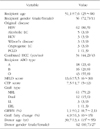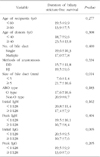1. Sanchez-Urdazpal L, Batts KP, Gores GJ, Moore SB, Sterioff S, Wiesner RH, et al. Increased bile duct complications in liver transplantation across the ABO barrier. Ann Surg. 1993. 218:152–158.

2. Gordon RD, Iwatsuki S, Esquivel CO, Tzakis A, Todo S, Starzl TE. Liver transplantation across ABO blood groups. Surgery. 1986. 100:342–348.
3. Gugenheim J, Samuel D, Reynes M, Bismuth H. Liver transplantation across ABO blood group barriers. Lancet. 1990. 336:519–523.

4. Reding R, Veyckemans F, de Ville de Goyet J, de Hemptinne B, Carlier M, Van Obbergh L, et al. ABO-incompatible orthotopic liver allografting in urgent indications. Surg Gynecol Obstet. 1992. 174:59–64.
5. Tanaka A, Tanaka K, Kitai T, Yanabu N, Tokuka A, Sato B, et al. Living related liver transplantation across ABO blood groups. Transplantation. 1994. 58:548–553.

6. Demetris AJ, Jaffe R, Tzakis A, Ramsey G, Todo S, Belle S, et al. Antibody-mediated rejection of human orthotopic liver allografts. A study of liver transplantation across ABO blood group barriers. Am J Pathol. 1988. 132:489–502.
7. Yandza T, Lambert T, Alvarez F, Gauthier F, Jacolot D, Huault G, et al. Outcome of ABO-incompatible liver transplantation in children with no specific alloantibodies at the time of transplantation. Transplantation. 1994. 58:46–50.

8. Farges O, Kalil AN, Samuel D, Saliba F, Arulnaden JL, Debat P, et al. The use of ABO-incompatible grafts in liver transplantation: a life-saving procedure in highly selected patients. Transplantation. 1995. 59:1124–1133.

9. Lo CM, Shaked A, Busuttil RW. Risk factors for liver transplantation across the ABO barrier. Transplantation. 1994. 58:543–547.

10. Egawa H, Ohdan H, Haga H, Tsuruyama T, Oike F, Uemoto S, et al. Current status of liver transplantation across ABO blood-type barrier. J Hepatobiliary Pancreat Surg. 2008. 15:131–138.

11. Egawa H, Teramukai S, Haga H, Tanabe M, Fukushima M, Shimazu M. Present status of ABO-incompatible living donor liver transplantation in Japan. Hepatology. 2008. 47:143–152.

12. Tanabe M, Kawachi S, Obara H, Shinoda M, Hibi T, Kitagawa Y, et al. Current progress in ABO-incompatible liver transplantation. Eur J Clin Invest. 2010. 40:943–949.

13. Tanabe M, Shimazu M, Wakabayashi G, Hoshino K, Kawachi S, Kadomura T, et al. Intraportal infusion therapy as a novel approach to adult ABO-incompatible liver transplantation. Transplantation. 2002. 73:1959–1961.

14. Nakamura Y, Matsuno N, Iwamoto H, Yokoyama T, Kuzuoka K, Kihara Y, et al. Successful case of adult ABO-incompatible liver transplantation: beneficial effects of intrahepatic artery infusion therapy: a case report. Transplant Proc. 2004. 36:2269–2273.

15. Usui M, Isaji S, Mizuno S, Sakurai H, Uemoto S. Experiences and problems pre-operative anti-CD20 monoclonal antibody infusion therapy with splenectomy and plasma exchange for ABO-incompatible living-donor liver transplantation. Clin Transplant. 2007. 21:24–31.

16. Pescovitz MD. Rituximab, an anti-cd20 monoclonal antibody: history and mechanism of action. Am J Transplant. 2006. 6(5 Pt 1):859–866.

17. Hanto DW, Fecteau AH, Alonso MH, Valente JF, Whiting JF. ABO-incompatible liver transplantation with no immunological graft losses using total plasma exchange, splenectomy, and quadruple immunosuppression: evidence for accommodation. Liver Transpl. 2003. 9:22–30.

18. Troisi R, Noens L, Montalti R, Ricciardi S, Philippé J, Praet M, et al. ABO-mismatch adult living donor liver transplantation using antigen-specific immunoadsorption and quadruple immunosuppression without splenectomy. Liver Transpl. 2006. 12:1412–1417.

19. Ikegami T, Taketomi A, Soejima Y, Yoshizumi T, Uchiyama H, Harada N, et al. Rituximab, IVIG, and plasma exchange without graft local infusion treatment: a new protocol in ABO incompatible living donor liver transplantation. Transplantation. 2009. 88:303–307.

20. Song GW, Lee SG, Hwang S, Kim KH, Ahn CS, Moon DB, et al. Dual living donor liver transplantation with ABO-incompatible and ABO-compatible grafts to overcome small-for-size graft and ABO blood group barrier. Liver Transpl. 2010. 16:491–498.

21. Song GW, Lee SG, Moon DB, Ahn CS, Hwang S, Kim KH, et al. Successful ABO incompatible adult living donor liver transplantation with new simplified protocol without local infusion therapy and splenectomy. J Korean Soc Transplant. 2011. 25:95–105.

22. Kawagishi N, Takeda I, Miyagi S, Satoh K, Akamatsu Y, Sekiguchi S, et al. Long-term outcome of ABO-incompatible living-donor liver transplantation: a single-center experience. J Hepatobiliary Pancreat Surg. 2009. 16:468–472.

23. Ohdan H, Zhou W, Tanaka Y, Irei T, Fuchimoto Y, Egawa H, et al. Evidence of immune tolerance to blood group antigens in a case of ABO-incompatible pediatric liver transplantation. Am J Transplant. 2007. 7:2190–2194.

24. Stussi G, West L, Cooper DK, Seebach JD. ABO-incompatible allotransplantation as a basis for clinical xenotransplantation. Xenotransplantation. 2006. 13:390–399.

25. Chang JH, Lee IS, Choi JY, Yoon SK, Kim DG, You YK, et al. Biliary stricture after adult right-lobe living-donor liver transplantation with duct-to-duct anastomosis: long-term outcome and its related factors after endoscopic treatment. Gut Liver. 2010. 4:226–233.

26. Duailibi DF, Ribeiro MA Jr. Biliary complications following deceased and living donor liver transplantation: a review. Transplant Proc. 2010. 42:517–520.

27. Hwang S, Lee SG, Sung KB, Park KM, Kim KH, Ahn CS, et al. Long-term incidence, risk factors, and management of biliary complications after adult living donor liver transplantation. Liver Transpl. 2006. 12:831–838.

28. Egawa H, Oike F, Buhler L, Shapiro AM, Minamiguchi S, Haga H, et al. Impact of recipient age on outcome of ABO-incompatible living-donor liver transplantation. Transplantation. 2004. 77:403–411.











 PDF
PDF ePub
ePub Citation
Citation Print
Print







 XML Download
XML Download